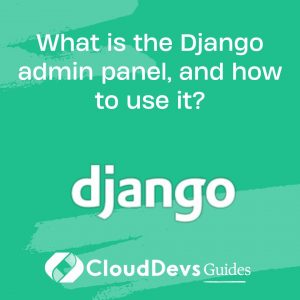What is the Django admin panel, and how to use it?
The Django admin panel is a built-in, user-friendly interface that allows developers and administrators to manage the data and administration of a Django project effortlessly. It provides a convenient way to perform common tasks such as creating, reading, updating, and deleting data in your database without having to write custom views or templates. Here’s an overview of what the Django admin panel is and how to use it:
Accessing the Django Admin Panel:
To access the Django admin panel, you’ll need to ensure that it’s enabled in your project’s settings. Open your project’s `settings.py` file and locate the `INSTALLED_APPS` list. Make sure `’django.contrib.admin’` is included in the list. Then, in your project’s main `urls.py` file, import and include the admin site by adding the following lines:
```python
from django.contrib import admin
urlpatterns = [
# ...
path('admin/', admin.site.urls),
# ...
]
``` Now, when you run the development server (`python manage.py runserver`) and navigate to `http://localhost:8000/admin/` in your web browser, you’ll see the login page for the admin panel.
Using the Django Admin Panel:
- Login: To get started, log in with the superuser account you created earlier using the `createsuperuser` command. Once logged in, you’ll have access to the admin panel.
- Dashboard: The admin panel provides a dashboard that displays all the registered app models. Each app can have multiple models, and you can click on any model to manage its data.
- Model Management: Clicking on a model takes you to a list view where you can see all the records in the database for that model. You can filter, search, and sort the records. Clicking on a record allows you to view and edit its details.
- Add New Data: You can add new records by clicking the “Add” button, which opens a form to enter the data. This is particularly helpful for adding data to your database quickly.
- Edit and Delete Data: You can edit existing data by clicking on a record and making changes. To delete a record, select it and click the “Delete” button.
- Customization: The Django admin panel can be customized extensively. You can define how each model is displayed, set up custom admin actions, and even create custom admin views if needed.
- Permissions: You can control who has access to the admin panel and what they can do by defining permissions and groups in Django’s built-in authentication system.
The Django admin panel is a powerful tool for managing the data and administration of your Django project. It simplifies common administrative tasks and provides an intuitive interface for interacting with your application’s data, making it an invaluable tool for developers and administrators.






